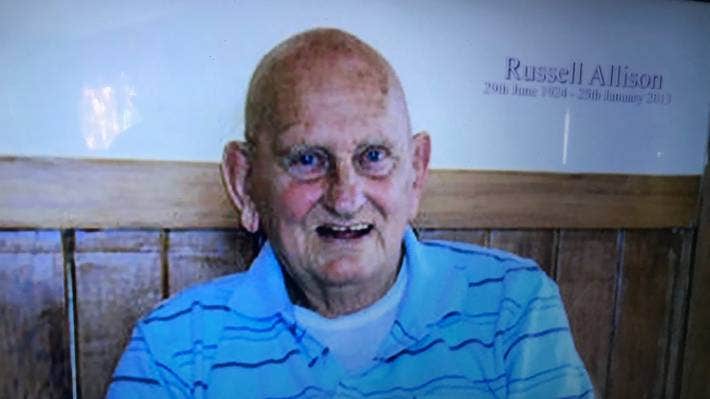He was last seen by colleagues in a huge industrial building to the south of the mill.
A week later, an acid vat was drained after his hard hat was found beside it.
It contained low-strength acid that could not have decomposed a body.
The only things they found were some of Donnelly’s keys, his work ID card, palm pilot, safety glasses and money. Inside, his work glasses, credit card and cash were discovered. His work key was also discovered – however Mr Donnelly’s wife, Tracey, says it had been removed from the rest of his keys, which have never been found.
Possible Sightings:
An officer found tracks from boots that could have matched ones issued to Donnelly, south of the mill. They went over a bank and disappeared into grass around the ponds. His wife does not believe this was her husband. She said other workers wore similar boots and “maybe it was someone trying it make it look like he had walked away”.
Three days later a digger operator saw someone fitting his description “running for his life” from searchers.
Donnelly was also reportedly seen behaving unusually at an office block in central Auckland the night before he disappeared.
He was presumed to have been looking for his best friend, Stephen Taylor, who worked there.
The building’s resident caretaker reportedly said Donnelly sneaked through a secure car park after an office worker.
When questioned, he said he had come to see someone working in the building and to help his friend pay a debt.
He described Jim Donnelly as quite frightened, pretty baffling and a bit incoherent.
Jim’s wife remembers the week before her husband disappeared was very unusual.
He had asked her to come home early on two occasions so he could tell her why he wanted to join the Freemasons.
He stopped “engaging” with her, would not say why he was anxious and “out-of-sorts” and disappeared for hours for walks.
Two days before he went missing – a Saturday – they were supposed to go to the Hyatt for a romantic night out but he fled unexpectedly for an “urgent meeting”. He returned hours later in a hired suit and said he had decided to go out with her after all.
Tracey says she “lost it”. She asked her parents and friends to talk to Donnelly but he would not tell them what was going on.
The same day he warned Tracey he might be a “bit fragile” the next day but would not say why.
She asked him if he meant emotionally or physically. He said physically.
He disappeared for about two hours, but came back happier.
Tracey says he told her: “If you knew what was in my head you would not be worried. Family comes first, family is most important.”
On the day before his disappearance he went for another walk and came back in body “but not in mind”.
He talked of trying to “avert a crisis, a waste” and said he had a problem at work. He paced the floor, ate little and fled again.
“It was like he was trying to make a decision about something,” says Tracey.
On the day he disappeared, Donnelly woke Tracey to tell her about presents he had bought for his children’s birthdays, which were months away.
Searches: Tracey believed he may have had an accident, but the theory shifted. Search and rescue teams thought he may have had a mental breakdown and was actively evading them.
Police investigating his disappearance looked into four scenarios: an accident, a suicide, a staged disappearance and foul play. David Glossop, the area commander of Counties Manukau west area, investigated Jim’s case in 2010.
Some of his co-workers described Jim’s behaviour as strange on the Monday too.
Mill workers were only interviewed on a voluntary basis; police officers were escorted throughout the search.
His wife felt the mill has been less than cooperative, including refusing access to a private investigator Tracey wanted to hire. She feels they failed to protect a staff member and have yet to be held accountable.
Mill-owner New Zealand Steel refused to be interviewed for the podcast, but in a statement took issue with Tracey’s frustrations, saying it cooperated fully with the police investigation including “full searches of our site” and support for those affected.
“NZ Steel has not received any further queries from authorities since the original investigation, but would of course be willing to help if that changed.”
In 2010 -Howick Senior Sergeant Dave Glossop looked into the case.
He is bringing a “fresh pair of eyes” to the case and has already had more than 50 search and rescue professionals scouring 900ha around Glenbrook Mill for two days.
That was where Donnelly was last seen on June 21, 2004. The area includes a mill, a beach and acres of concrete-lined oxidation ponds.
They used GPS technology not readily available at the time and the detective has re-interviewed mill managers to probe if there was “absolutely anywhere a body could’ve been laid”. Glossop has also been investigating if sonar radars – used by the FBI in the US to find hidden graves under houses – could be used to search the oxidation ponds. That area has never been “fully ticked off” by police.
“As technology moves on so does the police ability to make more inquiries,” says Glossop.
Glossop says the original police file contained “rumours” of a boat in the bays on one edge of the mill land.
He has been talking to harbour masters about any boats that could have been there and picked someone up.
He is also planning to talk to an independent psychologist for a take on Donnelly’s state of mind when he was last seen.
Glossop says it is “possible” Donnelly could have run away, assumed a new identity and restarted life.
But none of his credit cards had been used and there was no evidence for this.
It is also “possible” there could have been a fatal accident, suicide or murder.
But what bothers Glossop, and Jims’ wife, are a string of events that don’t add up.
They have heard nothing from him and Glossop describes the placing of the items in the acid vat as “staged”.
He said Donnelly was unlikely to have left them because he would have had to walk through the factory where people were searching for him.
If you have any information regarding this case, please contact Counties Manukau police: 09 261 1300 or Crimestoppers 0800 555 111
https://www.nzherald.co.nz/nz/news/article.cfm?c_id=1&objectid=10623319


























